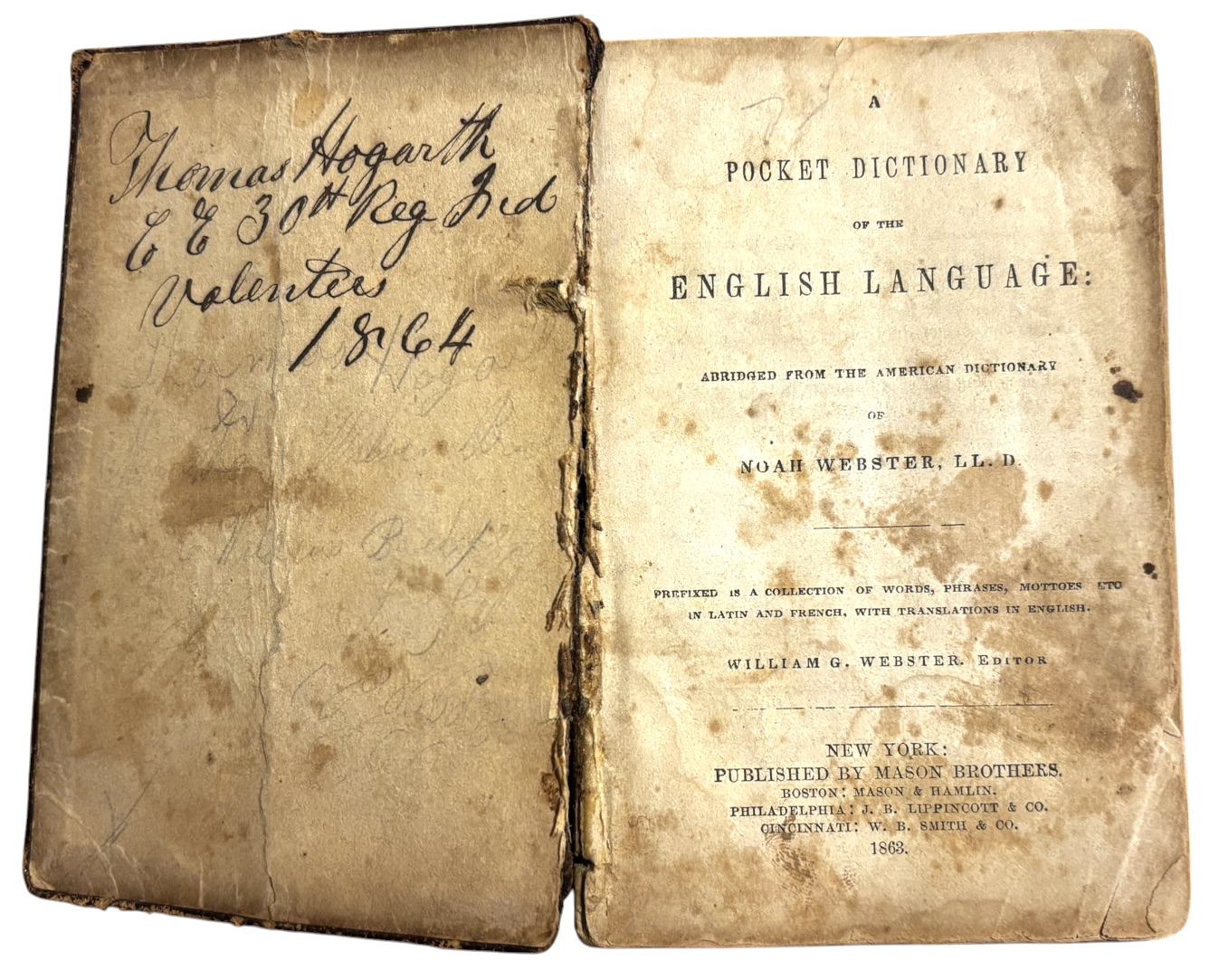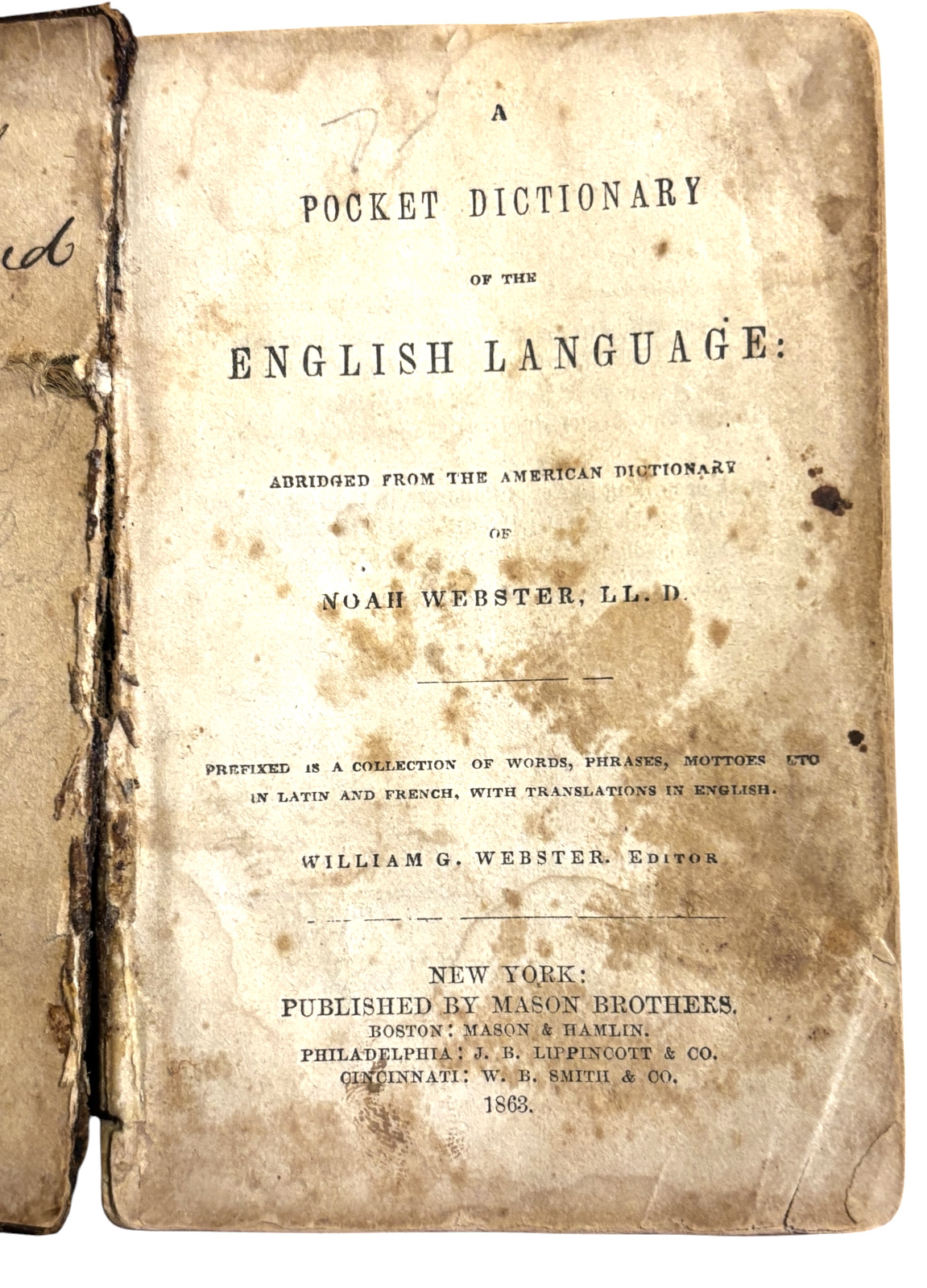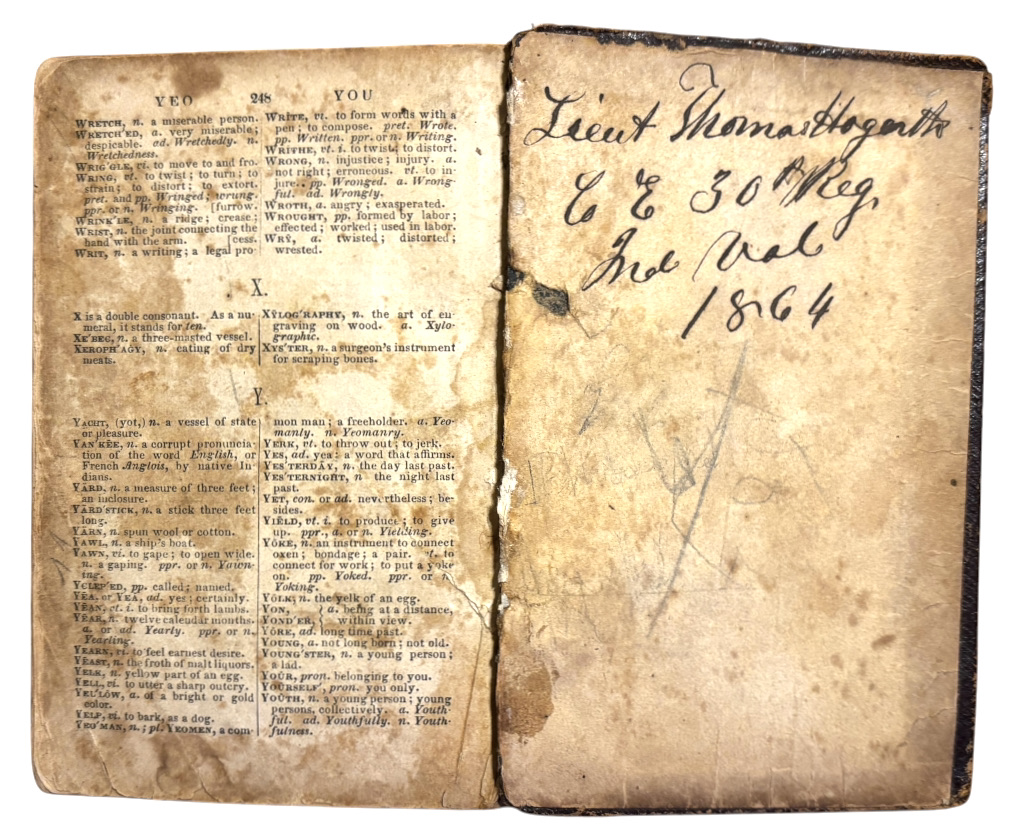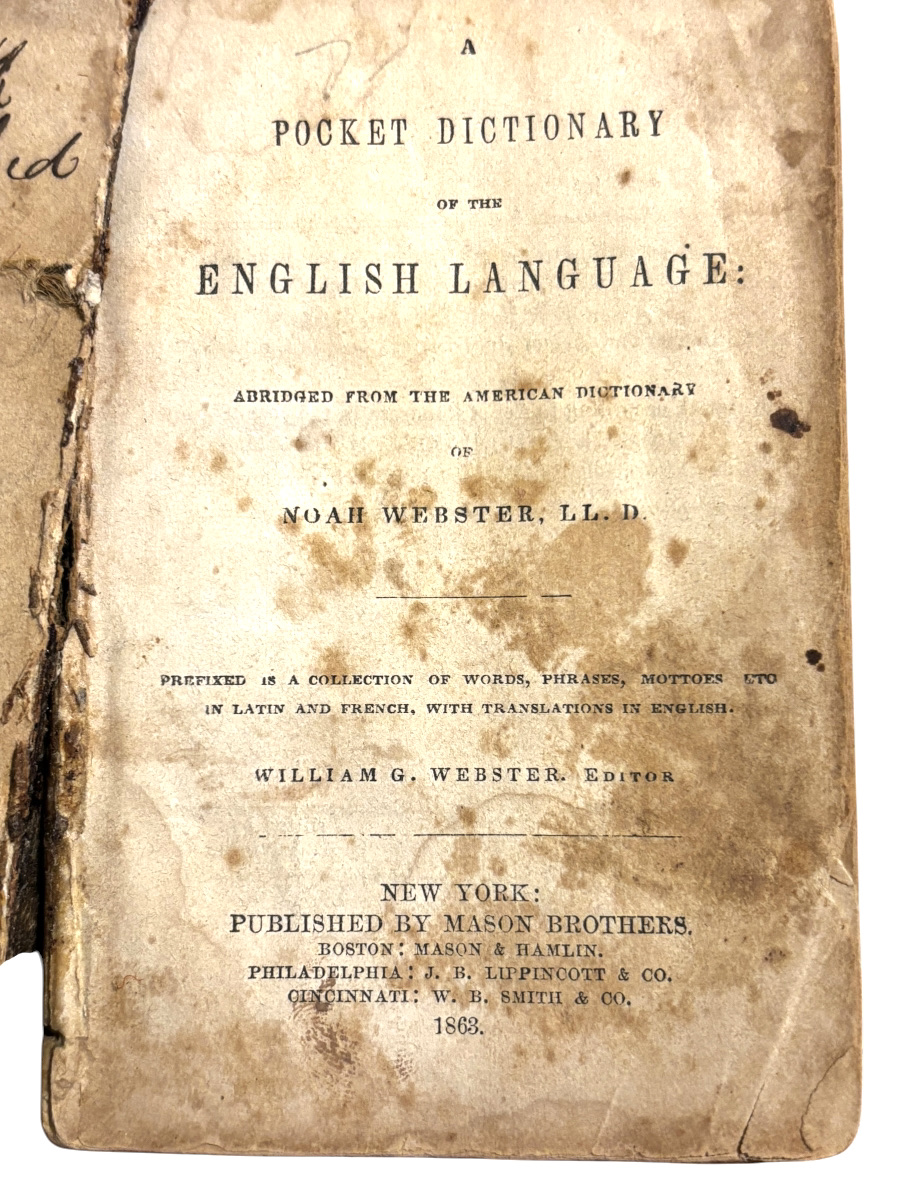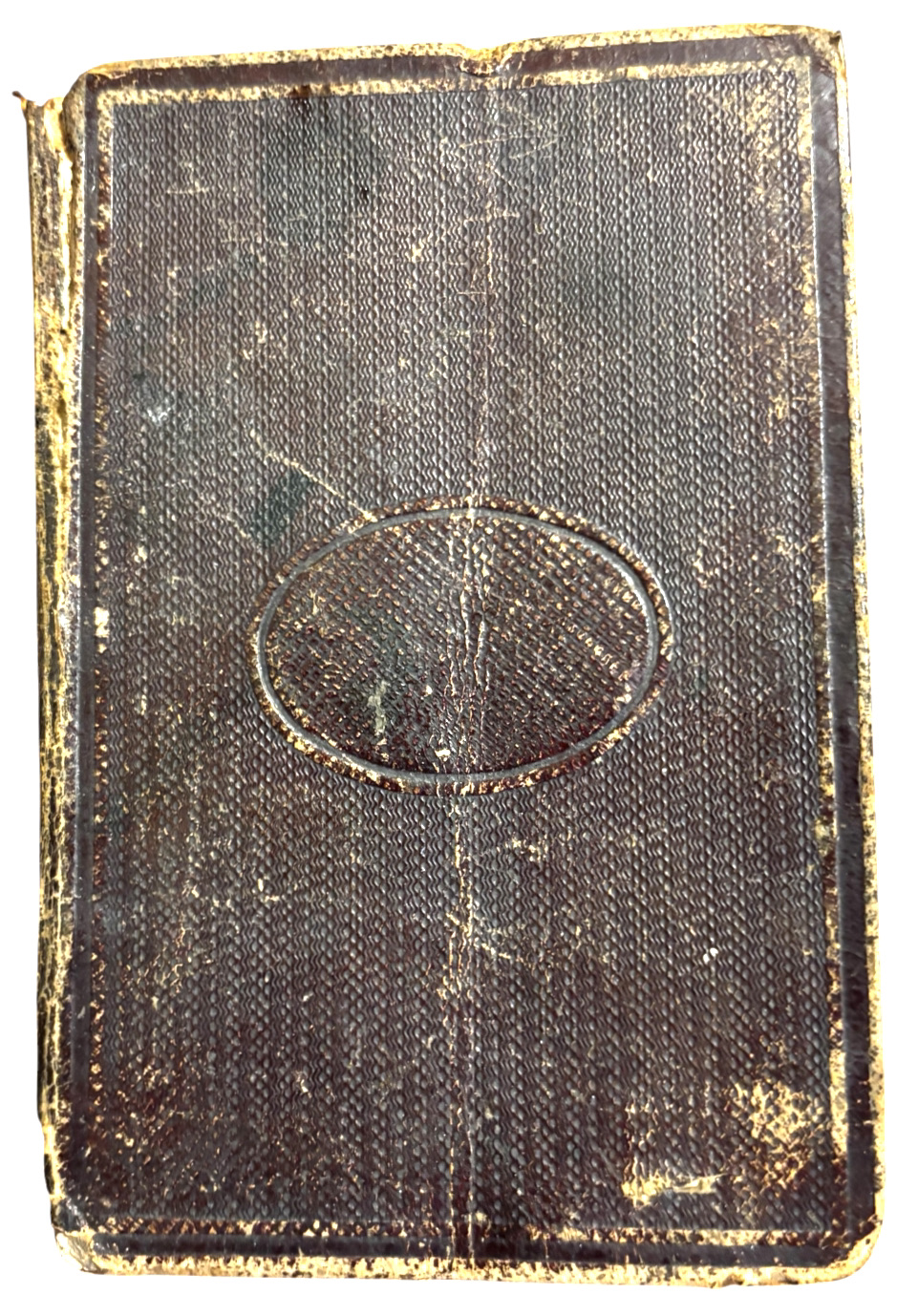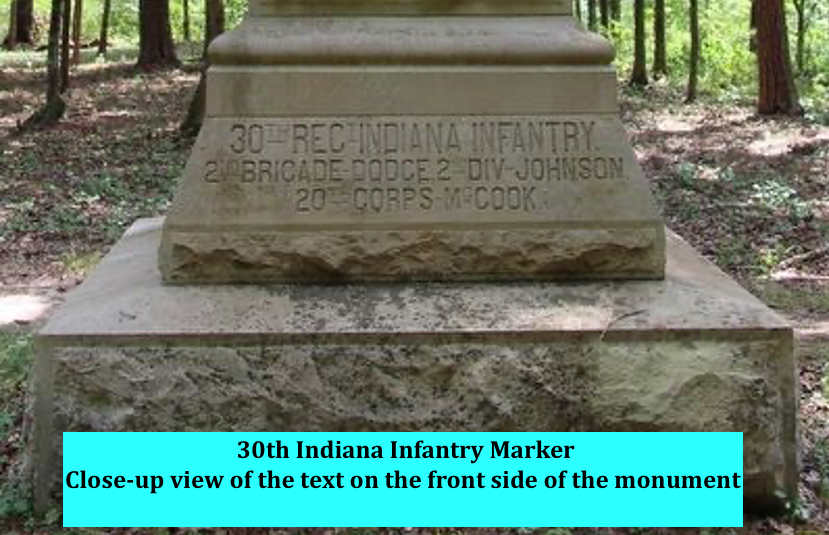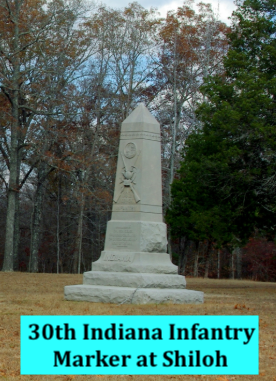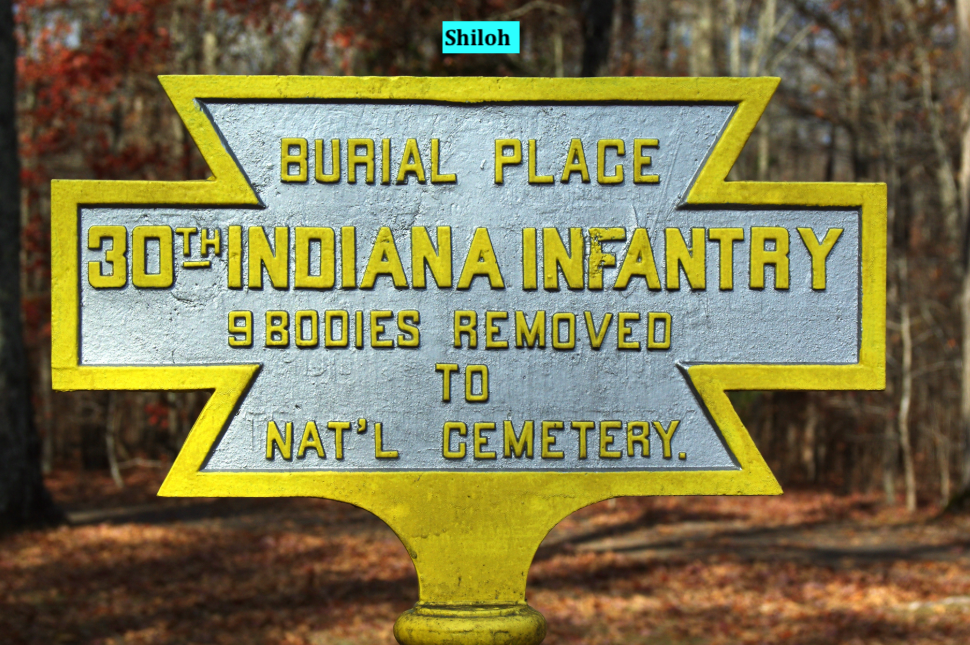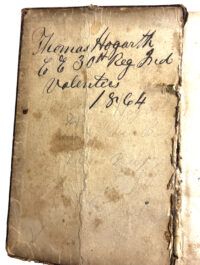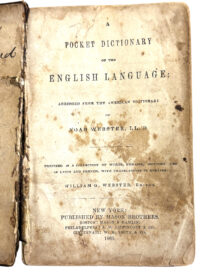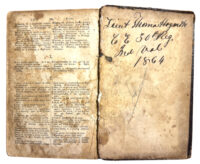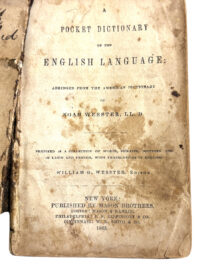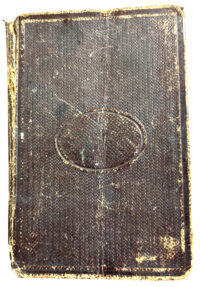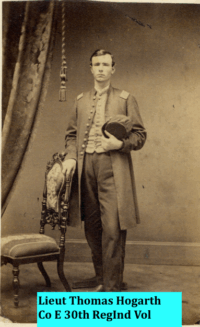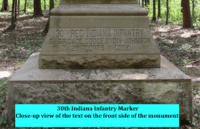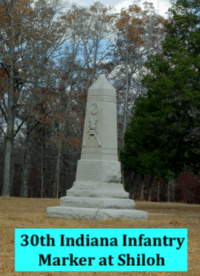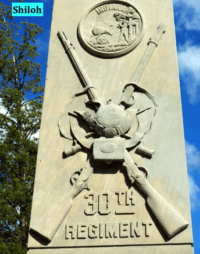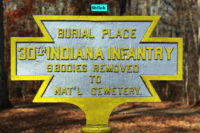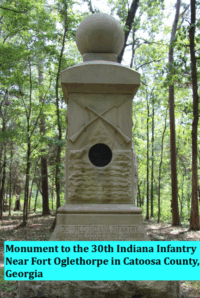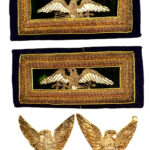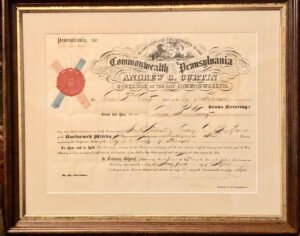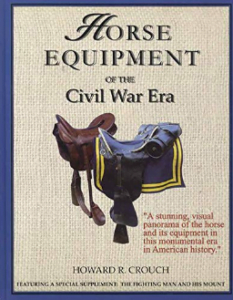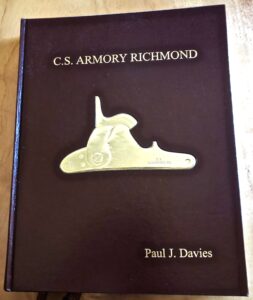Civil War Soldier’s Pocket Dictionary Id’d to Lt. Thomas Hogarth Co. E 30th Indiana Infantry
SOLD
Civil War Soldier’s Pocket Dictionary Id’d to Lt. Thomas Hogarth Co. E 30th Indiana Infantry – This diminutive dictionary, an abridged version of Noah Webster’s “American Dictionary”, was published in 1863 and is entitled: “A Pocket Dictionary of the English Language”. Inked on the paper affixed to the interior of the front board is the following:
“Thomas Hogarth
Co E 30th Reg Ind
Volenteers (sic)
1864”
Inked on the paper attached to the interior of the back board is the following:
“Lieut Thomas Hogarth
Co E 30th Reg
Ind Vol
1864”
This small dictionary is leather bound and retains both boards and spine; the front board is loosely attached to the spine and a small section of the leather is missing at the bottom of the spine; the spine has a gilded title that reads: “WEBSTERS POCKET DICTIONARY”. It appears that all of the original pages are in the dictionary, although there are no words listed and defined for the letter Z. The book exhibits some water staining and having been carried in the field by Hogarth, perhaps in his haversack.
Thomas Hogarth enlisted at the age of 18, initially in July, 1861, into Co. E of the 9th Indiana Infantry, but quickly transferred, in September, 1861, to Co. E of the 30th Indiana Infantry. Hogarth was soon appointed to the rank of Sergeant in the 30th Indiana, later rising to the rank of 2nd Lt. in 1863 and finally to the rank of Captain in late 1864. During his service, Hogarth would participate in numerous engagements to include: Shiloh, Corinth, Stones River, Chickamauga, the Atlanta Campaign, Kennesaw Mountain, Resaca and the Battles of Franklin and Nashville. This pocket dictionary was carried through numerous battles in the western theater of the war, by a youthful, battle-hardened veteran.
Thomas Hogarth
Residence Allen County, IN.
Enlisted on 4/24/1861 as a Priv.
On 4/24/1861, he mustered into “E” Co. Indiana 9th Infantry.
He was Mustered Out on 7/29/1861 at Indianapolis, IN
On 9/24/1861, he mustered into “E” Co. Indiana 30th Infantry.
He was Mustered Out on 9/29/1864 at Atlanta, GA
Promotions:
- Sergt 9/24/1861 (As of Co. E 30th IN Infantry)
- 2nd Lieut 6/13/1863
- Capt 12/19/1864 (As of Co. F)
Intra-regimental company transfers
- 12/19/1864 From company E to company F
9th IN Infantry
Organized: Indianapolis, IN on 4/22/1861
Mustered out: 7/29/1861
Ninth Infantry INDIANA (3 months and 3 years) Ninth Infantry. Cols., Robert H. Milroy, Gideon C. Moody, William H. Blake, Isaac C. B. Suman; Lieut.-Cols., David M. Dunn, Gideon C. Moody William H. Blake Isaac C. B. Suman, William P. Laselle, Majs., Daniel J. Woodward, William H. Blake, John B. Milroy, William P. Laselle, George H. Carter, James D. Braden. This regiment was organized at Indianapolis in April, 1861, for the three months’ service, and was mustered in on April 25. It left the state May 25, being the first organization to 26. go from Indiana to western Virginia. Reaching Grafton, June 1, it marched to Philippi, where it took part in the engagement of June 3. It was assigned to Gen. Morris’ brigade and participated in the marches and skirmishes of that command, being engaged at Laurel Hill and Carrick’s Ford. It was mustered out at Indianapolis, Aug. 2, 1861. Its original strength was 786; it lost 5 by death and 1862. by desertion 3. The regiment was reorganized at Laporte in Aug. 1861, and was mustered in Sept. 5, for three years. It left the state soon afterward for western Virginia, went into quarters at Cheat Mountain, and was engaged at Green River and camp Alleghany. On Jan. 9, 1862, it marched to Fetterman, was transferred to Buell’s army on Feb. 19 and sent to Nashville, where it was assigned to Nelson’s division, with which it participated in the second day’s battle of Shiloh. It was in the siege and capture of Corinth; joined in the pursuit of the enemy to Booneville; marched to Nashville by way of Athens and Murfreesboro; then moved to Bowling Green, Ky.; back to Nashville, thence to Louisville, joined in pursuit of Bragg’s army to the Wild Cat mountains; was engaged at Perryville, Danville and Wild Cat Mountain; and fought at Stone’s river. In 1863 it marched to Chattanooga, was in the battles of Chickamauga, Lookout Mountain and Missionary Ridge, then marched to Bridgeport, Ala., and thence to Whiteside, Tenn., where it reenlisted as a veteran organization Dec. 12. It was furloughed home in Jan., 1864, and rejoined its command at Cleveland, Tenn., late in February. It participated in the Atlanta campaign, being engaged at Taylor’s Ridge and Buzzard Roost, Resaca, Cassville, Dallas, New Hope Church, Kennesaw mountain, Marietta, Peachtree Creek, the investment of Atlanta, Jonesboro, and Lovejoy’s Station. It joined in pursuit of Hood’s army to Athens, Ala., and then moved to Pulaski, Tenn., reaching there Nov. 1, 1864. It was in the action at Columbia; in the heavy skirmishing on the route to Franklin in the battle at that place Nov. 30, participated in the battle of Nashville, joined in the pursuit of Hood as far as Huntsville, Ala.; was in camp there from Jan. 6 to Mar. 13, 1865, and moved to Nashville about May 25. It was sent to Louisiana and Texas, as part of Sheridan’s army of occupation and was mustered out Sept. 28, 1865. Its original strength was 1,057; it gained by recruits, 747; reenlistments, 291; unassigned recruits, 46; total, 2,141. Loss by death, 351, desertion, 125; unaccounted for, 18.
30th IN Infantry
Organized: Fort Wayne, IN on 9/24/1861
Mustered out: 11/25/1865
Thirtieth Infantry INDIANA (3 years) Thirtieth infantry.ÄCols., Sion S. Bass, Joseph B. Dodge; Lieut. Cols., Joseph B. Dodge, Orrin D. Hurd, Henry W. Lawton; Majs., Orrin D. Hurd, George W. Fitzsimmons, William Dawson. This regiment was organized at Fort Wayne in the summer of 1861, and was mustered in Sept. 24. It left the state at once for Camp Nevin, Ky., where it reported to Gen. Rousseau. It was attached to McCook’s brigade, moved with Buell’s army to Munfordville and Bowling Green, and in March, 1862, to Nashville. It was in the second day’s fight at Shiloh, where Col. Bass was fatally wounded and at his death a few days later, Lieut.-Col. Dodge was appointed colonel. The losses of the regiment were heavy. It was in the siege of Corinth and after its fall marched with Buell’s command through Alabama and Tennessee to Kentucky in pursuit of Bragg’s army. Returning to Nashville, it moved with Rosecrans’ army toward Murfreesboro, taking part at Stone’s River, where it lost heavily. It was actively engaged in the campaign that followed, and at Chickamauga it again received severe punishment. It then moved to Whiteside and Tyner’s Station, Tenn., where a small number reenlisted in December, being re-mustered at Blue Springs in Jan., 1864, and furloughed home. The regiment remained at Blue Springs until April and then moved with Gen. Thomas in the Atlanta campaign, participating in nearly all the battles and skirmishes of that movement. At Atlanta the non-veterans were mustered out. The veterans and recruits were consolidated into a battalion of seven companies on Dec. 3, 1864, and placed in command of Capt., afterward Lieut.-Col. Henry W. Lawton. The battalion moved with the 4th corps into East Tennessee, but returned to Nashville and participated in the battle with Hood in December, pursuing the Confederates to Huntsville, Ala., and then marching with the 4th corps into East Tennessee. It returned to Nashville, where it remained until June 1865, and was then sent to Texas. A company of the 36th regiment, commanded by Capt. John Swisher, was transferred to the 30th on July 12, and designated Co. H. The battalion continued as part of the army of occupation in Texas until it was mustered out Nov. 25, 1865. The original strength of the regiment was 1,011; gain by recruits, 276; reenlistments, 121; total, 1,408. It lost by death, 365; desertion, 67; unaccounted for, 70.
30th Indiana Infantry Regiment
| 30th Regiment Indiana Infantry | |
| Active | September 24, 1861 – November 25, 1865 |
| Country | United States |
| Allegiance | Union |
| Branch | Infantry |
| Engagements | Battle of Shiloh Siege of Corinth Battle of Stones River Tullahoma Campaign Battle of Chickamauga Atlanta Campaign Battle of Resaca Battle of Kennesaw Mountain Siege of Atlanta Battle of Jonesboro Second Battle of Franklin Battle of Nashville |
Service
The 30th Indiana Infantry was organized at Fort Wayne, Indiana, and mustered in for a three-year enlistment on September 24, 1861, under the command of Colonel Sion S. Bass.
The regiment was attached to Wood’s 2nd Brigade, McCook’s Command, at Nolin, Kentucky, to November 1861. 5th Brigade, Army of the Ohio, to December 1861. 5th Brigade, 2nd Division, Army of the Ohio, to September 1862. 5th Brigade, 2nd Division, I Corps, Army of the Ohio, to November 1862. 2nd Brigade, 2nd Division, Right Wing, XIV Corps, Army of the Cumberland, to January 1863. 2nd Brigade, 2nd Division, XX Corps, Army of the Cumberland, to October 1863. 3rd Brigade, 1st Division, IV Corps, Army of the Cumberland, to June 1865. 2nd Brigade, 1st Division, IV Corps, to August 1865. Department of Texas to November 1865.
The 30th Indiana Infantry mustered out of service on November 25, 1865.
Detailed service
Ordered to Camp Nevin, Kentucky, and reported to General Rousseau October 9. Camp at Nolin River, Kentucky, until February 1862. March to Bowling Green, Kentucky, then to Nashville, Tennessee, February 14-March 3. March to Savannah, Tennessee, March 16-April 6. Battle of Shiloh, April 6–7. Advance on and siege of Corinth, Mississippi, April 29-May 30. Pursuit to Booneville May 31-June 6. Buell’s Campaign in northern Alabama and middle Tennessee June to August. March to Louisville, Kentucky, in pursuit of Bragg, August 21-September 26. Pursuit of Bragg into Kentucky October 1–22. Near Clay Village October 4. Battle of Perryville, October 8 (reserve). March to Nashville, Tennessee, October 22-November 7, and duty there until December 26. Reconnaissance toward Lavergne November 19. Reconnaissance to Lavergne November 26–27. Lavergne, Scrougesville November 27. Advance on Murfreesboro December 26–30. Battle of Stones River December 30–31, 1862 and January 1–3, 1863. Duty at Murfreesboro until June. Tullahoma Campaign June 23-July 7. Liberty Gap June 24–27. Occupation of middle Tennessee until August 16. Passage of the Cumberland Mountains and Tennessee River and Chickamauga Campaign August 16-September 22. Battle of Chickamauga September 19–20. Duty at Whiteside, Tyner’s Station, and Blue Springs, Tennessee, until April 1864. Demonstration on Dalton, Georgia, February 22–27, 1864. Near Dalton February 23. Tunnel Hill, Buzzard’s Roost Gap and Rocky Faced Ridge February 23–25. Atlanta Campaign May 1-September 3. Tunnel Hill May 6–7. Demonstrations on Rocky Faced Ridge and Dalton May 8–13. Buzzard’s Roost Gap May 8–9. Battle of Resaca May 14–15. Near Kingston May 18–19. Near Cassville May 19. Advance on Dallas May 22–25. Operations on line of Pumpkin Vine Creek and battles about Dallas, New Hope Church, and Allatoona Hills May 25-June 5. Operations about Marietta and against Kennesaw Mountain June 10-July 2. Pine Hill June 11–14. Lost Mountain June 15–17. Assault on Kennesaw June 27. Ruff’s Station, Smyrna Camp Ground, July 4. Chattahoochee River July 5–17. Peachtree Creek July 19–20. Siege of Atlanta July 22-August 25. Flank movement on Jonesboro August 25–30. Battle of Jonesboro August 31-September 1. Lovejoy’s Station September 2–6. Operations against Hood in northern Georgia and northern Alabama September 20-November 3. Consolidated to a battalion of 7 companies October 3. Nashville Campaign November–December. Columbia, Duck River, November 24–27. Battle of Franklin November 30. Battle of Nashville December 15–16. Pursuit of Hood to the Tennessee River December 17–28. Moved to Huntsville, Alabama, and duty there until March 1865. Operations in eastern Tennessee March 15-April 22. Duty at Nashville until June. Moved to New Orleans, Louisiana, June 16, then to Texas in July, and duty at various points until November.
Casualties
The regiment lost a total of 412 men during service; 4 officers and 133 enlisted men killed or mortally wounded, 1 officer and 274 enlisted men died of disease.
Commanders
- Colonel Sion S. Bass
- Colonel Joseph B. Dodge – commanded at the battle of Stones River
- Lieutenant ColonelOrrin D. Hurd – commanded at the battles of Stones River and Chickamauga
- CaptainHenry Ware Lawton – commanded at the battle of Nashville
- Captain Oliver McMahan – commanded at the Battle of Shiloh
Notable members
- Captain Henry Ware Lawton, Company A – Medal of Honorrecipient for action during the siege of Atlanta; rose to the rank of major general and killed in the Philippine–American War
- Corporal William Augustine Ogden, Company C – composer
Civil War Journal of Thomas Hogarth III Transcription by 2nd Great Granddaughter Denise Hogarth Bumford Introduction Civil War Journal 1863 Thomas Hogarth III (1843-1906) As transcribed by Denise Hogarth Bumford, 2nd Great Granddaughter
extension://efaidnbmnnnibpcajpcglclefindmkaj/https://www.nps.gov/stri/learn/historyculture/upload/Thos_Hogarth_Civil_War_Journal_Transcription_508.pdf
Thomas Hogarth
Birth: Mar. 16, 1843.
Death: May 21, 1906.
Burial: Fernhill Memorial Gardens and Mausoleum, Stuart, Martin County, Florida.
Enlisted 9th., Indiana infantry, company E., 1861/04/18, at Fort Wayne, Indiana, age 18, discharged 1861/07/29.
Enlisted 30th., Indiana, infantry company F., 1863/06/23, at Manchester, Tennessee, age 21, discharged 1865/11/25. Remarks; Reorganized. 2nd Lt. Originally Enlisted as Sgt. at Ft. Wayne, August 27, 1861. Prom to 2nd Lt., June 29, 1863 to Capt., February 10, 1865.
Inscription – On the Shiloh Monument to the 30th Indiana Infantry
30th
Regiment
Infantry
Commanded by
Col. Sion S. Bass,
5th Brigade – Col. E.N. Kirk –
2nd Division – Gen. McCook –
Army of the Ohio.
Indiana
(back)
30th
Infantry.
Commanded by
Col. Sion S. Bass
(mortally wounded)
Lieut. Col. Joseph B. Dodge,
Major Orin Hurd.
Inscription on the Monument to the 30th Indiana Infantry near Camp Oglethorpe in Georgia
30th Regiment Indiana Infantry
2nd Brigade – Dodge, 2nd Division – Johnson.
20th Corps – McCook.
Text on Back Side of the Monument:
Indiana’s Tribute
To Her
Thirtieth Regiment Infantry.
Lieutenant Colonel Orrin D. Hurd, Commanding.
Second Brigade (Dodge).
Second Division (Johnson).
Twentieth Corps (McCook).
September 19th, 1863, this regiment, with its brigade, came into the field near Crawfish Springs; at 1 p.m., moved to the left and went into action north of the Brock Field driving the enemy some distance in a bitterly contested struggle. After some movements to the left, night came on, when the enemy attacked, and after two hours fighting the regiment moved to the line southeast of the Kelly Field.
Morning of September 20th, threw up breastworks and resisted an assault at 9 a.m., was then removed to this position and at 12 m., was heavily attacked but held the line. About 5 p.m. the line was again attacked, and soon after withdrew under
30th Indiana Infantry Marker
Close-up view of the text on the front side of the monument
orders to the woods west of the Kelly Field, thence to Rossville.
Casualties: killed; 2 officers, 8 men; wounded; 5 officers, 50 men; captured; 4 officers, 57

